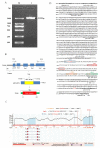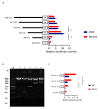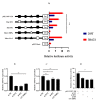Transcriptional Regulation of HMOX1 Gene in Hezuo Tibetan Pigs: Roles of WT1, Sp1, and C/EBPα
- PMID: 32224871
- PMCID: PMC7231170
- DOI: 10.3390/genes11040352
Transcriptional Regulation of HMOX1 Gene in Hezuo Tibetan Pigs: Roles of WT1, Sp1, and C/EBPα
Abstract
Heme oxygenase 1 (HMOX1) is a stress-inducing enzyme with multiple cardiovascular protective functions, especially in hypoxia stress. However, transcriptional regulation of swine HMOX1 gene remains unclear. In the present study, we first detected tissue expression profiles of HMOX1 gene in adult Hezuo Tibetan pig and analyzed the gene structure. We found that the expression level of HMOX1 gene was highest in the spleen of the Hezuo Tibetan pig, followed by liver, lung, and kidney. A series of 5' deletion promoter plasmids in pGL3-basic vector were used to identify the core promoter region and confirmed that the minimum core promoter region of swine HMOX1 gene was located at -387 bp to -158 bp region. Then we used bioinformatics analysis to predict transcription factors in this region. Combined with site-directed mutagenesis and RNA interference assays, it was demonstrated that the three transcription factors WT1, Sp1 and C/EBPα were important transcription regulators of HMOX1 gene. In summary, our study may lay the groundwork for further functional study of HMOX1 gene.
Keywords: HMOX1 gene; Hezuo Tibetan pig; promoter; transcriptional regulation.
Conflict of interest statement
The authors declare no conflicts of interest.
Figures





Similar articles
-
Analysis of the Xenopus laevis CCAAT-enhancer binding protein alpha gene promoter demonstrates species-specific differences in the mechanisms for both auto-activation and regulation by Sp1.Nucleic Acids Res. 2001 Jan 15;29(2):362-72. doi: 10.1093/nar/29.2.362. Nucleic Acids Res. 2001. PMID: 11139605 Free PMC article.
-
Modulation of the expression of the invasion-suppressor CRMP-1 by cyclooxygenase-2 inhibition via reciprocal regulation of Sp1 and C/EBPalpha.Mol Cancer Ther. 2008 Jun;7(6):1365-75. doi: 10.1158/1535-7163.MCT-08-0091. Epub 2008 Jun 4. Mol Cancer Ther. 2008. PMID: 18524846
-
Sequential repression and activation of the CCAAT enhancer-binding protein-alpha (C/EBPalpha ) gene during adipogenesis.Proc Natl Acad Sci U S A. 2000 Nov 7;97(23):12519-23. doi: 10.1073/pnas.220426097. Proc Natl Acad Sci U S A. 2000. PMID: 11050170 Free PMC article.
-
Opposing roles of C/EBPα and eEF1A1 in Sp1-regulated miR-122 transcription.RNA Biol. 2020 Feb;17(2):202-210. doi: 10.1080/15476286.2019.1673656. Epub 2019 Oct 7. RNA Biol. 2020. PMID: 31561740 Free PMC article.
-
Pathological significance of heme oxygenase-1 as a potential tumor promoter in heme-induced colorectal carcinogenesis.Cancer Pathog Ther. 2023 Apr 13;2(2):65-73. doi: 10.1016/j.cpt.2023.04.001. eCollection 2024 Apr. Cancer Pathog Ther. 2023. PMID: 38601482 Free PMC article. Review.
Cited by
-
Zoledronic acid induces ferroptosis by reducing ubiquinone and promoting HMOX1 expression in osteosarcoma cells.Front Pharmacol. 2023 Jan 4;13:1071946. doi: 10.3389/fphar.2022.1071946. eCollection 2022. Front Pharmacol. 2023. PMID: 36686696 Free PMC article.
-
Population Genetic Analysis of Six Chinese Indigenous Pig Meta-Populations Based on Geographically Isolated Regions.Animals (Basel). 2023 Apr 18;13(8):1396. doi: 10.3390/ani13081396. Animals (Basel). 2023. PMID: 37106959 Free PMC article.
-
CircRNA profiling reveals the regulatory role of circPAN3 in Hezuo boars Sertoli cell growth.BMC Genomics. 2024 Dec 30;25(1):1258. doi: 10.1186/s12864-024-11170-9. BMC Genomics. 2024. PMID: 39736570 Free PMC article.
-
Transcriptional Regulation of RIP2 Gene by NFIB Is Associated with Cellular Immune and Inflammatory Response to APEC Infection.Int J Mol Sci. 2022 Mar 30;23(7):3814. doi: 10.3390/ijms23073814. Int J Mol Sci. 2022. PMID: 35409172 Free PMC article.
References
Publication types
MeSH terms
Substances
LinkOut - more resources
Full Text Sources

